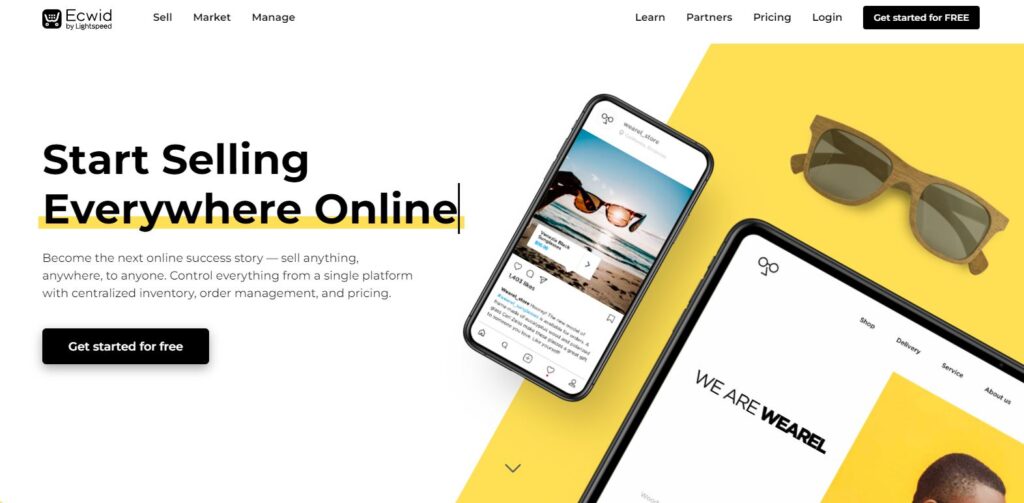In the ever-evolving landscape of business, the year 2024 presents unprecedented opportunities for entrepreneurs to establish and thrive in the online realm. The rise of e-commerce continues to reshape the business ecosystem, offering a gateway to global markets and unparalleled scalability. In this comprehensive guide, we will explore the key steps and strategies to embark on the journey of starting an online business with e-commerce in 2024.
Table of Contents
ToggleUnderstanding the E-commerce Landscape
The first step in your entrepreneurial journey is gaining a profound understanding of the e-commerce landscape. As of 2024, e-commerce has become an integral part of the global economy, with trillions of dollars in transactions taking place annually. It is crucial to be aware of the latest trends, technologies, and consumer behaviors that shape the e-commerce environment.
Market Research and Niche Identification
Before diving into the e-commerce arena, conduct thorough market research to identify potential niches and assess market demand. Leveraging advanced analytics tools and trend analysis will enable you to pinpoint lucrative opportunities and understand consumer preferences. Choosing a niche that aligns with your passion and expertise will increase your chances of long-term success.
E-commerce Platform Selection
Selecting the right e-commerce platform is a critical decision that influences the overall functionality and user experience of your online store. In 2024, leading platforms like Shopify, WooCommerce, and BigCommerce offer robust features, customizable templates, and seamless integration with third-party tools. Evaluate each platform based on your business requirements, scalability, and ease of use.
Setting Up Your Online Store
With the foundation laid through comprehensive market research and platform selection, it’s time to set up your online store.
Domain Name and Branding
Choose a memorable and brandable domain name that reflects your business identity. Crafting a compelling brand story and designing an eye-catching logo are essential elements in establishing a strong brand presence.
In a competitive online landscape, differentiation through branding can be a key factor in attracting and retaining customers and you want a domain name that’s unique and resonates with your business. You can buy a domain from any hosting provider. My recommended hosting company is Hostinger as you can domain for only $3.00 per year.
Product Listings and Descriptions
In the dynamic realm of e-commerce, the significance of product listings and descriptions cannot be overstated. These elements serve as the digital shopfront, inviting potential customers into your online store and guiding them through a seamless shopping experience. In 2024, where visual aesthetics and informative content play pivotal roles, mastering the art of product presentation is essential for capturing the attention and trust of your target audience.
Visual Appeal: High-Quality Imagery
The adage “a picture is worth a thousand words” holds true in the online retail space. High-quality, professionally shot images are the cornerstone of effective product listings. In 2024, where high-resolution displays are ubiquitous, customers expect crystal-clear visuals that showcase every detail of the product. Multiple images from different angles, close-ups of intricate features, and lifestyle shots demonstrating product use can significantly enhance the visual appeal.
Descriptive and Informative Copy
Beyond captivating visuals, the written content accompanying each product is equally vital. Product descriptions should be more than just a list of features; they should tell a compelling story. Provide potential customers with information that goes beyond the basics, highlighting the unique selling points and benefits of the product. Consider the following aspects when crafting product descriptions:
Unique Selling Proposition (USP): Clearly articulate what sets your product apart from the competition. Whether it’s superior quality, innovative features, or a compelling backstory, emphasize what makes your offering special.
Key Features and Specifications: Present a concise list of the product’s key features and specifications. Organize this information in a format that is easy to scan, allowing customers to quickly grasp the product’s capabilities.
Use Cases and Benefits: Describe how the product can address the needs and desires of your target audience. Highlight the practical benefits and potential use cases to help customers envision the value your product brings to their lives.
Storytelling and Brand Voice: Infuse personality into your product descriptions by adopting a consistent brand voice. Share the story behind the product, conveying authenticity and creating an emotional connection with your audience.
Video Content Integration
As online shopping becomes more immersive, incorporating video content into product listings has emerged as a powerful trend. Short product videos can provide a dynamic showcase, allowing customers to see the product in action. Whether it’s a demonstration of functionality, a virtual tour, or customer testimonials, videos add an extra layer of engagement that static images alone may not achieve.
Interactive Elements
In the ever-evolving landscape of e-commerce, interactive elements within product listings can elevate the customer experience. Consider incorporating features such as 360-degree product views, zoom-in functionality, or interactive product configurators. These elements empower customers to explore the product in detail, fostering a sense of control and engagement.
User-Generated Content (UGC)
Harness the power of user-generated content by featuring customer reviews, photos, and testimonials within your product listings. In 2024, consumers value authenticity, and seeing real-life experiences from fellow customers can instill confidence and trust. Encourage customers to share their thoughts and experiences, and prominently display this UGC to build a sense of community around your brand.
SEO Optimization
Optimizing product listings for search engines is paramount for enhancing discoverability. Conduct thorough keyword research related to your products and incorporate relevant terms naturally into your product titles, descriptions, and metadata. This not only improves your search engine rankings but also ensures that your products are easily found by customers actively searching for similar items.

A/B Testing and Iterative Improvement
The e-commerce landscape is dynamic, and consumer preferences can evolve. Implement A/B testing strategies to assess the effectiveness of different product listing elements, including images, copy, and interactive features. Regularly analyze the performance metrics and customer feedback to identify areas for improvement and refinement.
Payment and Security Measures
In the rapidly advancing landscape of e-commerce, where convenience is paramount, establishing robust payment and security measures is non-negotiable. As consumers increasingly entrust sensitive information to online platforms, ensuring the confidentiality and integrity of transactions is vital for building trust and fostering long-term customer relationships. In 2024, the following aspects are crucial for fortifying the payment and security infrastructure of your online business.
Secure Payment Gateways
Selecting a secure and reputable payment gateway is the first line of defense in safeguarding transactions. In 2024, leading e-commerce platforms offer a variety of payment gateways with built-in security features. Prioritize gateways that comply with Payment Card Industry Data Security Standard (PCI DSS) requirements, ensuring that customer payment information is handled with the highest level of security.
Encryption Protocols
Implement robust encryption protocols, particularly Secure Sockets Layer (SSL) or Transport Layer Security (TLS), to secure the transmission of data between the customer’s browser and your website. This encryption ensures that sensitive information, such as credit card details, remains confidential and cannot be intercepted by malicious actors.
Two-Factor Authentication (2FA)
Integrate two-factor authentication mechanisms to add an extra layer of security to user accounts. By requiring users to verify their identity through a secondary method, such as a unique code sent to their mobile device, you reduce the risk of unauthorized access even in the event of compromised passwords.
Tokenization
Consider implementing tokenization, a method where sensitive data, such as credit card numbers, is replaced with unique tokens. Even if a cybercriminal gains access to the token, it holds no value without the corresponding decryption key. This enhances security by minimizing the exposure of actual card details in your systems.
Fraud Detection and Prevention
Leverage advanced fraud detection tools and machine learning algorithms to identify and prevent fraudulent transactions. These tools analyze patterns, anomalies, and user behavior to flag potentially fraudulent activities, providing an additional layer of protection against cyber threats.
Transparent Security Communication
Clearly communicate your commitment to security on your website. Display security badges, SSL certificates, and other relevant indicators to assure customers that their transactions are conducted in a secure environment. Transparent communication builds trust and instills confidence in your brand.
Regular Security Audits and Updates
Conduct regular security audits to identify vulnerabilities and address potential weaknesses in your system. Stay informed about the latest security threats and update your systems promptly to patch any known vulnerabilities. This proactive approach is essential in the ever-evolving landscape of cybersecurity.
Data Minimization and Retention Policies
Adopt data minimization principles by only collecting the information necessary for transaction processing. Implement clear data retention policies to specify how long customer data will be stored and the circumstances under which it will be deleted. This not only reduces the risk of data breaches but also aligns with privacy regulations.
Compliance with Payment Regulations
Stay abreast of the latest payment regulations and compliance standards in the regions where you operate. Adherence to global standards, such as the Payment Services Directive (PSD2) in Europe, not only ensures legal compliance but also enhances the overall security posture of your e-commerce platform.
Customer Education on Security Practices
Empower your customers with knowledge about security best practices. Provide resources and guidance on creating strong passwords, recognizing phishing attempts, and securing their devices. Educated customers are more likely to play an active role in maintaining the security of their accounts.
Incident Response Plan
Develop a comprehensive incident response plan outlining the steps to be taken in the event of a security breach. This proactive approach enables you to respond swiftly, minimize damage, and communicate transparently with affected customers, preserving trust even in challenging situations.
In conclusion, prioritizing payment and security measures is not only a necessity in the e-commerce landscape of 2024 but also a strategic investment in the long-term success of your online business. By adopting a multi-layered security approach, staying vigilant against emerging threats, and fostering transparent communication with customers, you can build a secure and resilient foundation for your e-commerce venture.
Digital Marketing Strategies
In the digital age, effective marketing is crucial for the success of any online business. In 2024, the competition is fierce, making it imperative to deploy diverse digital marketing strategies.
Search Engine Optimization (SEO)
Optimize your online store for search engines to increase visibility and organic traffic. Stay updated on the latest SEO trends and algorithms to ensure your website ranks high in relevant search results. Focus on keyword research, content quality, and backlink building to strengthen your online presence.
Social Media Marketing
Leverage the power of social media platforms to connect with your target audience. Develop a comprehensive social media strategy, utilizing platforms like Instagram, Facebook, Twitter, and LinkedIn to promote products, engage with customers, and build a community around your brand.
Influencer Collaborations
In 2024, influencer marketing continues to be a potent tool for reaching wider audiences. Identify influencers in your niche and collaborate with them to amplify your brand message. Authentic partnerships can drive brand awareness and generate trust among potential customers.
Email Marketing Automation
Implement email marketing automation to nurture leads, engage customers, and drive repeat business. Personalized and targeted email campaigns based on customer behavior can significantly boost conversion rates. Utilize data analytics to refine your email marketing strategy over time.

Logistics and Fulfillment
Efficient logistics and order fulfillment are paramount in ensuring a seamless customer experience.
Inventory Management
Implement robust inventory management systems to track stock levels, prevent over-selling, and streamline order fulfillment. In 2024, advanced technologies such as artificial intelligence (AI) and machine learning can be harnessed to optimize inventory forecasting and replenishment.
Shipping and Delivery Optimization
Customers expect fast and reliable shipping options. Collaborate with reputable shipping partners to offer competitive delivery times. Explore innovative solutions such as drone deliveries and same-day shipping to stay ahead of the competition.
Customer Experience and Retention
In the crowded e-commerce landscape, providing an exceptional customer experience is key to fostering loyalty and driving repeat business.
Responsive Customer Support
Offer responsive and accessible customer support through multiple channels, including live chat, email, and social media. Swiftly address customer inquiries and concerns to build trust and satisfaction.
Loyalty Programs and Incentives
Implement loyalty programs and incentives to reward repeat customers and encourage brand loyalty. Exclusive discounts, early access to new products, and personalized offers can go a long way in retaining customers.
Data Analytics for Continuous Improvement
Utilize data analytics tools to gather insights into customer behavior, preferences, and purchasing patterns. Analyzing this data enables you to make informed decisions, optimize your marketing strategies, and enhance the overall customer experience.
Adapting to Technological Advances
As technology continues to evolve, staying abreast of the latest advancements is crucial for maintaining a competitive edge.
Augmented Reality (AR) and Virtual Reality (VR)
Explore the integration of AR and VR technologies to enhance the online shopping experience. Virtual try-ons and augmented product displays can provide customers with a more immersive and personalized view of your products.
Blockchain for Transparency
Implement blockchain technology to enhance transparency in your supply chain. In an era where consumers prioritize ethical and sustainable practices, blockchain can provide verifiable information about the origin and journey of products.
Legal and Regulatory Compliance
Navigating the legal aspects of e-commerce is vital for a sustainable and compliant business.
Data Privacy and GDPR Compliance
Adhere to data privacy regulations, such as the General Data Protection Regulation (GDPR), to safeguard customer information. Clearly communicate your data usage policies and ensure that your business practices comply with international privacy standards.
E-commerce Regulations and Taxation
Stay informed about e-commerce regulations and taxation policies in the regions where you operate. Compliance with local laws is essential for avoiding legal issues and ensuring smooth business operations.
Creating Your E-commerce Store
The digital era has ushered in unprecedented opportunities for entrepreneurs to establish thriving online businesses. If you’re considering delving into the realm of e-commerce, this comprehensive guide will serve as your roadmap to creating a successful online store. From conceptualization to launch, we’ll explore the key steps and considerations for turning your e-commerce aspirations into a reality.
1. Define Your Niche and Products
a. Market Research: Before you dive into creating your e-commerce store, conduct thorough market research. Identify a niche that aligns with your interests and has a demand in the market. Analyze your target audience, competitors, and industry trends to uncover opportunities for differentiation.
b. Product Selection: Choose the products you want to sell carefully. Consider factors such as market demand, profit margins, and your passion for the products. Whether you’re selling physical goods, digital products, or services, ensure there is a viable market for what you plan to offer.
2. Choose Your E-commerce Platform
a. Platform Selection: Selecting the right e-commerce platform is a pivotal decision. Ecwid is a popular e-commerce platform for beginners and offers its own set of features and customization options.

Ecwid: Revolutionizing E-commerce with Simplicity and Power
In the bustling world of online commerce, Ecwid stands out as a game-changer, providing businesses with a versatile and user-friendly platform to sell, market, and manage their products effortlessly. As a leading free e-commerce shopping cart and online store solution, Ecwid empowers entrepreneurs to embark on their online journey without the hassle of coding or complex development processes.
Start Selling Everywhere Online
Unparalleled Accessibility: With Ecwid, your first steps into the online marketplace are just a few clicks away. Whether you’re selling products, services, digital goods, or subscriptions, Ecwid enables you to manage everything from a centralized platform. From your desk to on-the-go, you have the control to build your dream business without the need for developers or designers.
2022 Top Performer: Acknowledged as a top performer in small business e-commerce software, Ecwid provides a seamless starting point for businesses of all sizes. The platform’s commitment to user-friendly functionality positions it as a leader in empowering entrepreneurs to take charge of their online ventures.
Sell Everywhere with Ease
Global Reach: Ecwid allows you to bring your products and services to the world effortlessly. Start by selling on one channel and expand your reach across various platforms. Whether you want to build a new online store, connect to an existing website, sell on social media platforms like Facebook, Instagram, and TikTok, or integrate with online marketplaces such as Amazon, eBay, Walmart, and Google Shopping – Ecwid makes it possible.
On-the-Go Selling: With the Ecwid app for iOS and Android, you can sell on the go. This flexibility ensures that your business is not confined to a physical location, and you can reach customers wherever they are.
Grow Faster with Powerful Marketing Tools
Customer Attraction and Retention: Ecwid goes beyond facilitating sales; it helps you grow your business. Automated Google and Facebook ads, integrations with emerging platforms like TikTok, Pinterest, and Snapchat, customizable marketing emails, discount coupons, gift cards, and SEO tools are all part of the arsenal designed to attract and retain more customers.
Manage Simply and Efficiently
Automation and Integration: Ecwid understands the value of time and resources for businesses. That’s why it provides seamless integration with over a hundred payment and shipping options. Automate shipping, tax calculations, and inventory tracking to streamline your operations. Customize your catalog, checkout page, and customer notifications without needing coding skills.
User-Friendly Administration: Voted as the №1 Easiest Admin e-commerce platform in 2023, Ecwid simplifies the management of orders, products, promotions, and customers. The top-rated mobile app (available on iOS and Android) ensures that you can manage your business on the go.
Introducing Lightspeed Payments
Integrated Payment Solution: Ecwid introduces Lightspeed Payments, a fully integrated payment method for your customers. Accept one-off orders or sell products through subscriptions with ease. The system supports major cards, Google Pay, and Apple Pay, allowing you to manage payments directly from your store control panel.
Expert Support and a Growing Ecosystem
Continuous Support: Ecwid values your success, and expert support is available whenever you need it. Whether you’re navigating the initial setup or encountering challenges along the way, the live support ensures that you’re never alone in your e-commerce journey.
App Market and Mobile Management: Take your store to the next level with tools and apps from the Ecwid App Market. Manage your business on the go with the Ecwid Mobile App, providing flexibility and convenience in handling your online store.
Your Online Store – Effortless and Risk-Free
With Ecwid, your online store is just a few clicks away, and the best part – you can get started for free. No credit card is required; you only pay when you’re ready. Ecwid combines simplicity with powerful features, ensuring that your e-commerce venture is not only accessible but also equipped for success in the competitive online marketplace. Transform your ideas into reality, become the next online success story, and experience the freedom of selling anything, anywhere, to anyone with Ecwid.
For a video tutorial on how to setup you e-commerce store for free with Ecwid, watch the video below










